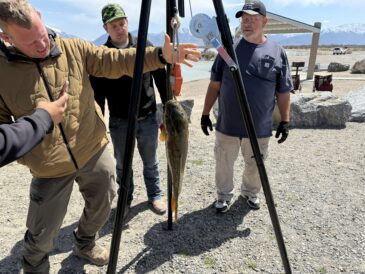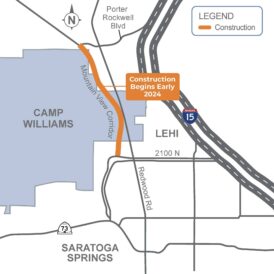Cave, museum are family’s heritage
KANAB — Four generations of Chamberlains have made a home of southern Utah’s high desert realm of breathtaking red rock and canyon-cut horizons.
But it is a 200-foot-deep hole drilled by the eons into the Navajo sandstone walls of Three Lakes Canyon Lex Chamberlain is most proud of.
“This my heritage,” the lanky, 6-foot-7 proprietor of the Moqui Cave said. “There’s been a lot of generations of sacrifice to bring us to where we are today.”
Today, Moqui Cave is a combination museum of geology, paleontology and Western history. For $4 (half that for children) visitors can view hundreds of samples making up one of the largest displays of fluorescent minerals in the nation. The cave also boasts one of Utah’s largest private collection of dinosaur footprints.
A gift shop displays carvings and sculptures by Lex’s late father, Garth, and other artists. It also offers American Indian jewelry, rugs and pre-Columbian artifacts.
Thousands of tourists drop by yearly, with crowds heaviest in the summer vacation months when temperatures top triple digits (inside the cave it is never warmer than 70 degrees Fahrenheit.)
“It’s hard work but provides a living,” Lex said, noting his wife, Lee Anne, and their five children all help. “People come in and ask about the area and its history and that’s exciting for me.”
Located about six miles north of the Utah-Arizona border town of Kanab, the Moqui Cave has been in the Chamberlain family for more than five decades. In those years, it has become synonymous with one of Utah’s oldest pioneer families.
Lex Chamberlain, 47, descends from Thomas and Hannah Chamberlain — great-great-grandparents who joined the Mormon migration West in 1852. The newcomers were dispatched by The Church of Jesus Christ of Latter-day Saints’ then-President Brigham Young to Tooele, where Thomas died a few years later.
His son, also named Thomas, who left western Utah for the hardscrabble south at age 20, became the first leader of an 1875-1885 Mormon communal experiment in Orderville, about seven miles north of the cave on what is now U.S. 89 between Bryce Canyon and Zion National Parks.
His son Guy was Lex’s grandfather.
It was Garth Chamberlain, though, who started the family’s long association with the cave.
Some recall Garth Chamberlain as an outgoing rebel with a gift for colorful, earthy language. His son smiles, acknowledging his father was “less active” in the Mormon church when he decided to buy the cave in 1951.
At first it didn’t seem like much: a sloping hole black with campfire soot and littered with beer bottles and trash from illicit, Prohibition-era drinking parties. Its darker recesses had become open lavatories.
Garth and his wife Laura cleaned up the place, sprayed 286 bags of cement on the walls and ceiling, leveled the floor and then covered it with 7,000 square feet of concrete and painted it white.
Using local stones and specimens he had collected from travels around the world, Garth fashioned inlaid, hand-crafted bartops.
The cave became a popular watering hole, especially when work began in the mid-1960s on the nearby Glen Canyon Dam.
The crowds also became rowdier, the disdain of predominantly Mormon neighbors more pronounced. After 12 years, the Moqui Cave dance hall ceased operation; the bar soon followed and tourism and the museum’s exhibits — legal to possess, since his father collected them with permission from private lands — became the new revenue generators.
In 1977, midway through his two-year church mission to Argentina, Lex learned his father’s resistance to his family’s faith had faded.
When Lex began his mission, Garth had agreed to close the cave on Sundays, a major concession in a longtime debate between father and son over observing the Sabbath.
A year later, Lex opened a letter. “Son, you’ll be happy to know that I’ve stopped selling beer and alcohol in the cave. I’ve started selling Books of Mormon,” his father wrote. “I don’t make as much money, but I sure feel a hell of a lot better.”
Garth Chamberlain died at 68 of a heart attack. Lex, then working as an interiors contractor in Mesa, Ariz., returned to Kanab to grieve — and help decide the fate of the family’s unique inheritance.
“My sister and brother told my mother to sell the cave and enjoy life,” Lex recalls. “I looked at them and said, ‘You guys are crazy to sell this. Don’t you realize all the labor of love and hard work our parents went tofi’ “
In the end, Lex and Lee Anne Chamberlain argued themselves into taking over the cave. Lex’s mother died two years ago at 81. Someday, the Chamberlains hope one of their three daughters or two sons will carry on family operation of the cave.
One fan of the cave is William Lund, a senior scientist with the Utah Geological Survey.
“It’s not just another tourist trap, but a landmark for the Kanab area,” he said. “I like visiting it because it showcases a lot of the interesting geological and archaeological things southwest Utah has to offer.”
This story appeared in The Daily Herald on page D5.



